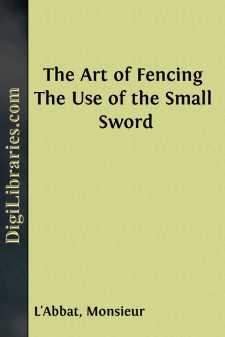Categories
- Antiques & Collectibles 13
- Architecture 36
- Art 48
- Bibles 22
- Biography & Autobiography 813
- Body, Mind & Spirit 142
- Business & Economics 28
- Children's Books 16
- Children's Fiction 13
- Computers 4
- Cooking 94
- Crafts & Hobbies 4
- Drama 346
- Education 46
- Family & Relationships 57
- Fiction 11829
- Games 19
- Gardening 17
- Health & Fitness 34
- History 1377
- House & Home 1
- Humor 147
- Juvenile Fiction 1873
- Juvenile Nonfiction 202
- Language Arts & Disciplines 88
- Law 16
- Literary Collections 686
- Literary Criticism 179
- Mathematics 13
- Medical 41
- Music 40
- Nature 179
- Non-Classifiable 1768
- Performing Arts 7
- Periodicals 1453
- Philosophy 64
- Photography 2
- Poetry 896
- Political Science 203
- Psychology 42
- Reference 154
- Religion 513
- Science 126
- Self-Help 84
- Social Science 81
- Sports & Recreation 34
- Study Aids 3
- Technology & Engineering 59
- Transportation 23
- Travel 463
- True Crime 29
The Art of Fencing The Use of the Small Sword
by: Monsieur L'Abbat
Categories:
Description:
Excerpt
CHAP. I.
Of chusing and mounting a Blade.
Courage and Skill being often of little Use without a good Weapon, I think it necessary, before I lay down Rules for using it, to shew how to chuse a good Blade, and how it ought to be mounted.
The Length of the Blade ought to be proportionable to the Stature of the Person who is to use it: The longest Sword, from Point to Pommel, should reach perpendicularly from the Ground to the Navel, and the shortest, to the Waste; being large in Proportion to its Length, and not extremely large, nor very small, as some People wear them; the over large Blades being unweildy, unless very hollow, which makes them weak, and the narrow ones being not sufficient to cover the Body enough.
In Order to chuse a good Blade, three Things are to be observed: First, that the Blade have no Flaw in it, especially across, it being more dangerous so than Length-way. Secondly, That it be well tempered, which you'll know by bending it against a Wall or other Place; if it bend only towards the Point, 'tis faulty, but if it bend in a semicircular Manner, and the Blade spring back to its Straitness, 'tis a good Sign; If it remains bent it is a Fault, tho' not so great as if it did not bend at all; for a Blade that bends being of a soft Temper, seldom breaks; but a stiff One being hard tempered is easily broke. The third Observation is to be made by breaking the Point, and if the Part broken be of a grey Colour, the Steel is good; if it be white 'tis not: Or you may strike the Blade with a Key or other Piece of Iron, and if he gives a clear Sound, there is no hidden Fault in it. In bending a Blade you must not force it, what I have said being sufficient to know it by, and besides by forcing it, it may be so weakened in some Part as to break when it comes to be used.
It would not be amiss for a Man to see his Sword mounted, because the Cutlers, to save themselves the Trouble of filing the inside of the hilts and pommel, to make the Holes wider, often file the Tongue of the Blade too much, and fill up the Vacancies with Bits of Wood, by which Means the Sword is not firm in the Hand, and the tongue being thin and weak, is apt to break in Parrying or on a dry Beat, as has been unhappily experienced. Care should also be taken that the End of the Tongue be well riveted to the Extremity of the Pommel, lest the Grip should fly off, which would be of very dangerous Consequence.
Some Men chuse strait Blades, others will have them bending a little upwards or downwards; some like them to bend a little in the Fort, and others in the Feeble, which is commonly called le Tour de Breteur, or the Bullie's Blade. The Shell should be proportionable in Bigness to the Blade, and of a Metal that will resist a Point, and the Handle fitted to the Hand.
Some like square Handles, and others chuse round Ones; the square are better and firmer in the Hand, but as this Difference depends on Fancy, as does also the Bow, which in some Cases may preserve the Hand, but may be a Hindrance in inclosing, I shall leave it to the Decision of the Fashions.
...

